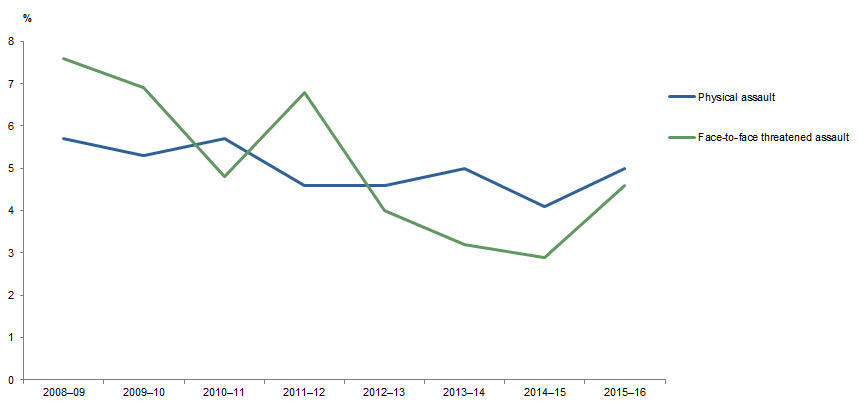NORTHERN TERRITORY
HOW HAVE PERSONAL CRIME VICTIMISATION RATES CHANGED OVER TIME?
No fitted functions that met the inclusion criteria were identified for physical assault or face-to-face threatened assault in Northern Territory.
VICTIMISATION RATES, Selected personal crimes, Northern Territory, 2008–09 to 2015–16(a)

Australian Bureau of Statistics
© Commonwealth of Australia 2017.
Footnote(s): (a) Data for non face-to-face threatened assault are not shown, as estimates for the number of persons experiencing non face-to-face threatened assault in the 12 months prior to interview are subject to high sampling error (for further details refer to the Technical Note).
Source(s): Crime Victimisation, Australia
HOW HAVE HOUSEHOLD CRIME VICTIMISATION RATES CHANGED OVER TIME?
No fitted functions that met the inclusion criteria were identified for break-in, attempted break-in, theft from a motor vehicle, malicious property damage or other theft in Northern Territory. Although no fitted function met the criteria for inclusion, there appears to be a decrease in the victimisation rate for malicious property damage since 2008–09. This finding should be used with caution.
VICTIMISATION RATES, Selected household crimes, Northern Territory, 2008–09 to 2015–16(a)

Australian Bureau of Statistics
© Commonwealth of Australia 2017.
Footnote(s): (a) Data for motor vehicle theft are not shown, as estimates for the number of persons experiencing motor vehicle theft in the 12 months prior to interview are subject to high sampling error (for further details refer to the Technical Note).
Source(s): Crime Victimisation, Australia
 Print Page
Print Page
 Print All
Print All
 Quality Declaration
Quality Declaration